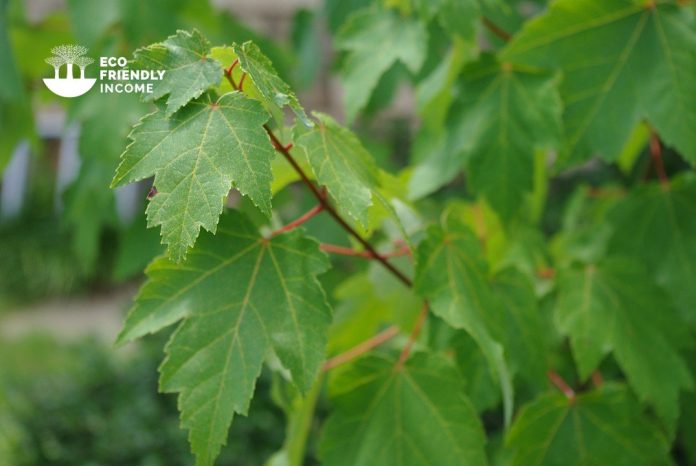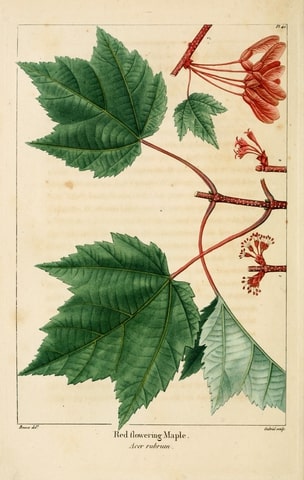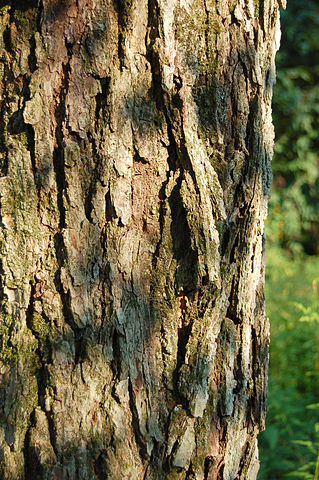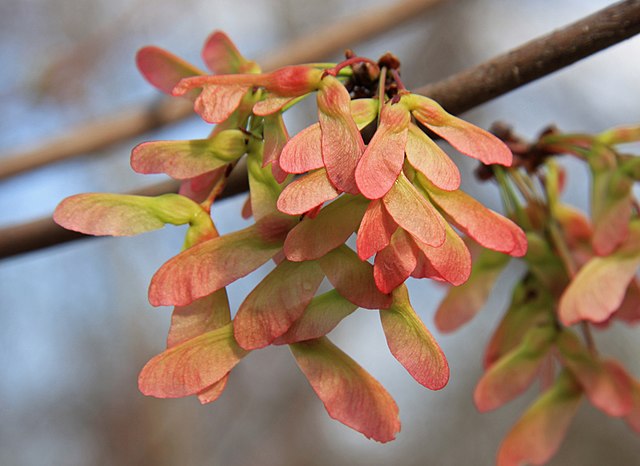
Featured Photo by Matt Lavin / CC BY-SA 2.0
A field guide on how to identify and propagate Red Maple (Acer rubrum), a hardy tree that is native to eastern North America.
How to Identify Red Maple (Acer rubrum)
Leaves

Red maple leaves have simple, 3 to 5-lobed leaves with doubly serrated margins, and are about 4-8 inches long. They grow in an opposite arrangement on the stems.
Their glossy leaves turn yellow at the end of the summer and into a striking red during fall.
Bark

Red maple bark is grayish-brown and smooth when the tree is young but develops fissures and ridges with age.
It’s characterized by shallow ridges, scaly plates, and shallow furrows, creating an overall scaly appearance.
If you look closely, some trees have a reddish tinge, especially on the trunk.
Flowering Season
In early spring, dark red buds give way to dense, short-stalked clusters of flowers.
Habitat
You can find Red maple growing near swamps, stream banks, lake shores, and wet woods. They are also common in residential areas and are popular as street trees.
Red maple is most commonly found in the Eastern Forests-Boreal Transition, Acadian & Great Lakes Forest ecoregions.
Wildlife Value
Red Maple trees provide a diverse array of wildlife values.
They are a common food source for many species of birds, small mammals, and other animals, providing seeds, buds, and fruits.
The tree also provides shelter, nesting sites, and perching spots for a variety of birds.
The dense foliage of the tree can provide cover and a habitat for many species of insects and other small creatures.
Additionally, Red Maple trees are important in watershed protection, providing shade to help keep water temperatures cooler, reduce soil erosion, and help filter pollutants.
How to Propagate Red Maple (Acer rubrum)

Hardiness Zone: 3-9

Soil Type: Acidic loam, sand. Clay.

Water: Normal to High.

Exposure: Full Sun to Partial Shade.
You can propagate red maple with two techniques that work quite well:
- By Seed: Higher success rate, and faster if you want to grow hundreds or thousands of plants.
- By Cuttings: Harder to master, but gives you established trees much faster than by seed.
Let’s take a look at both methods:
How to Propagate Red Maple (Acer rubrum) by Seed
Red maple creates hundreds, if not thousands of winged seeds. They’re super easy to collect, should you have some red maple trees growing nearby.
If not, no worries, you can always order red maple seeds online at Mont Royal Seeds.
How to Harvest Seeds

Red maple seeds start to fall on the ground usually around late September to early October.
It’s up to you if you want to pick them up off the ground, or simply collect them from the branches just a week or so before they fall.
Each ‘helicopter’ has two seeds, so you can harvest them quite quickly.
Now let them dry and the seed inside will be easier to extract.
Now that you got your seeds, the next step is to stratify.
Stratification
Maple seeds need at least a 90-day cold stratification.
You can plant them in pots and leave them out during winter for natural stratification, or do it yourself.
Here’s how stratify red maple seeds yourself:
- First, place the seeds in room-temperature water for around 24 hours.
- Next, put them in a ziplock bag with sand or vermiculite, moisten, and then partially seal.
- Then, place them into your refrigerator for 90 days (temperature should be 3-5 degrees Celcius).
Occasionally look to make sure they don’t dry out.
Now they are ready to sow!
Recommended sowing medium: peat moss mixed with sand.
You can put a plastic warp or cover over the pots to maintain moisture.
Seeds should sprout within a week.
How to Propagate Red Maple (Acer rubrum) by Cuttings
You can also propagate red maple by taking cuttings, this way you can have established plants faster.
With red maple, a good option is to take semi-hardwood cuttings.
That’s the new year’s growth that’s gone partly hard.
Generally, the rule of thumb here is to what about 60 days after the first shoots appear.
The ideal time is from mid-June to the end of August.

Now let’s look at how to do that:
- First, identify a branch that’s got new growth and take a closer look at the shoots.
- Find a piece of branch that’s not firm, brown old growth, it’ll be green but by now it will have gone semi-hard.
- Snip a shoot off just below a node, but don’t take branches too thin, 1/4 inch width minimum, and they should be 6-8 inches long.
- Next, remove the leaves except for 1-2 at the top, if they are too big cut the leaves in half.
- Use a razor blade to scuff the base of the cuttings and expose the cambium. Make a vertical line on opposite sides, about 1 inch long.
- Next, dip them in rooting hormones (IBA TALC 3000 PPM), knock off the excess with a light flick, then plant them into your propagation substrate.
- Finally, keep watering the rooting medium, the substrate shouldn’t be soggy but it should stay moist.
With proper warmth and moisture, roots should form within 4-6 weeks.
Recommended rooting medium: Indoor: 3:1 perlite to peat moss. Outdoor: Sand.
That’s it! That should have you covered on multiplying your red maples!
FAQ
Q: Where do Red Maples grow best?
A: Red maples can thrive in a range of conditions, including sunny or shady places, dry or wet soil, and high or low elevations.
Q: How fast do Red Maple trees grow?
A: On average, established red maple trees can grow from 1 to 2 feet per growing season.
Q: Do red maples make a mess?
A: They are susceptible to broken branches during storms but mostly the seeds falling off during fall can make a mess.
